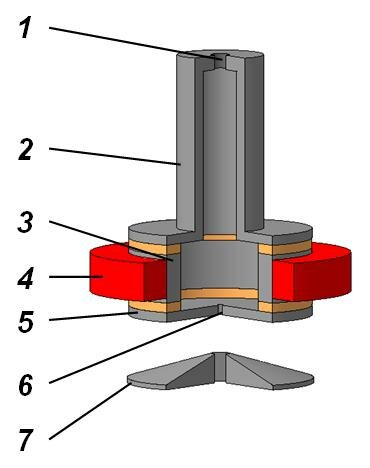|
|
|
| News |
|
14.11.2013 |
| Updated "Publications" |
|
more
|
07.12.2012 |
| Updated "Publications" |
|
more
|
07.12.2012 |
| Measurements of the electron beam brightness |
|
more
|
07.12.2012 |
| Updated "Photos" |
|
more
|
|
| Plasma-cathode electron gun |
|
|
The E-beam gun provides the stable parameters of the focused beam for a long time, even in "industrial" vacuum conditions and frequent losses of vacuum in the working chamber of the facility.
The guns remain in work condition on exposure to vapours of metals, including high-melting components, and to gases released from the weld zone.
Basis technical specifications
| Operation mode |
continuous, pulsed |
| Working pressure in the vacuum chamber, Torr |
10-4 |
| Accelerating voltage, kV |
up to 60 (reg.) |
| Beam current, mA |
up to 200 (reg.) |
| Maximum beam power, kW |
up to 12 (60kV) |
| Minimal beam diameter in focus, mm |
0,3 - 0,6 |
| Beam deflection angle, grad |
7 |
| Value of gas (air) flow in the discharge chamber, sm3/hour |
12-20 |
| Plasma-cathode gun weight, kg |
up to 60 |
Principle of operation
|
A plasma-cathode gun depends for its operation on electron emission from a plasma caused by a strong electric field. The emitting plasma is produced by a hollow-cathode low-voltage reflected discharge.
The discharge chamber is formed by a hollow cathode 2, a cylindrical anode 3, and an emitter cathode 5. The voltage necessary for the discharge initiation and operation is applied between the cathodes and the anode. A permanent magnet 4 creates a magnetic field of 0.08–0.1 T in the space between the hollow cathode and the emitter cathode.
It is common to use a low-voltage form of discharge, i.e. with a voltage 350–450V. This discharge exists when the gas pressure in the discharge chamber about 0.05–0.1mbar. It is a higher pressure than in the vacuum chamber of electron-beam setup. To maintain this pressure the working gas (usually air) was bled into the discharge chamber through the hollow cathode channel 1. The value of the gas flow is small and usually does not exceed 20cm3atm/h. Discharge is in continuous mode. The discharge current can be varied from 0.1A to about 1.5–1.8A, which allows a beam current from a fraction to several hundred milliamps to be obtained. The discharge current change leads to a change in beam current. This is the basis of principle of current control of the plasma-cathode electron gun. The accelerating voltage is applied to cathode 5 relative to a grounded accelerating electrode 7. The plasma electrons that leave the chamber through the emitter cathode channel 6 constitute a beam, which is focused by the magnetic field of a focusing lens.
|
The electrode assembly of gun

1 - the channel;
2 - a hollow cathode;
3 - an anode;
4 - a permanent magnet;
5 - an emitter cathode;
6 - the emission channel;
7 - an extractor.
|
|
|
|
|
© Elion (2011)
tel/fax: 007-3822-414859
e-mail: mail@elion-tomsk.ru
|
Developed by: INDEVISION
|
|
|
|